Chapter 3 Waves
3.1 General properties of waves
CORE
1. Know that waves transfer energy without transferring matter
2. Describe what is meant by wave motion as illustrated by vibrations in ropes and springs, and by experiments using water waves
3. Describe the features of a wave in terms of wavefront, wavelength, frequency, crest (peak), trough, amplitude and wave speed
4. Recall and use the equation for wave speed
v=fλ
5. Know that for a transverse wave, the
direction of vibration is at right angles to the direction of propagation and understand that electromagnetic radiation, water waves and seismic S-waves (secondary) can be modelled as transverse
6. Know that for a longitudinal wave, the direction of vibration is parallel to the direction of propagation and understand that sound waves and seismic P-waves (primary) can be modelled as longitudinal
7. Describe how waves can undergo:
(a) reflection at a plane surface
(b) refraction due to a change of speed
(c) diffraction through a narrow gap
8. Describe the use of a ripple tank to show:
(a) reflection at a plane surface
(b) refraction due to a change in speed caused by a change in depth
(c) diffraction due to a gap
(d) diffraction due to an edge
SUPPLEMENT
9. Describe how wavelength and gap size affects diffraction through a gap
10. Describe how wavelength affects diffraction at an edge
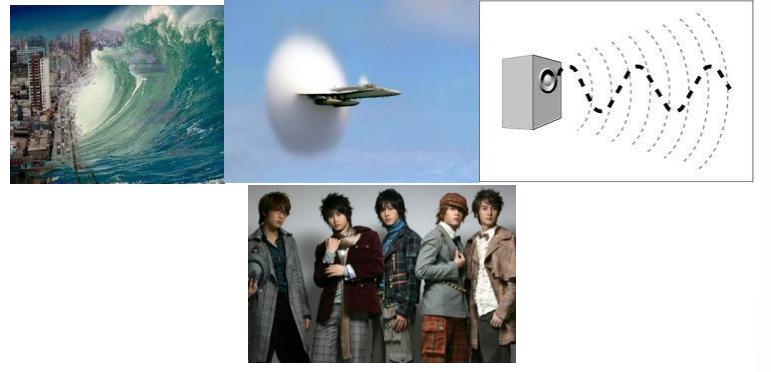
• Which of the picture above shows a wave in action?
• Waves transfer energy between points without transferring matter
• Best way to visualize this would be to use a slinky and shake it up and down.
• You will see a wave but the rings on the slink does not actually travel with the wave.
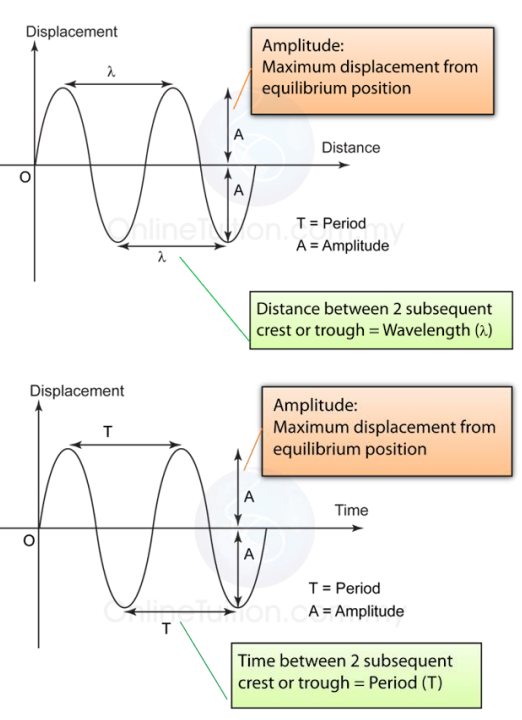
• Amplitude (A) is the maximum displacement from the original position.
• The SI unit for amplitude is in meters.
• Wavelength (λ) is the horizontal distance between two points that are in phase.
• The SI unit for amplitude is in meters as well.
• The period (T) is the time taken for the wave to complete a cycle or return to its original displacement.
• The SI unit for periods is seconds.
• Frequency (f) is the number of complete cycles in a second (i.e., how many times did the wave go up, down and up again or down, up, and down again in 1 second).
• The SI unit for frequency is hertz (Hz) OR \(seconds^{-1}\)
• Hence the relationship between frequency (f) and period (T) is
\(f=\frac{1}{T}\)
• The speed of a wave can be calculated using the following equation
Speed (m/s) = Frequency (Hz) x Wavelength (m)
v = f x λ
• There are two types of waves.
• In a transverse wave, particles vibrate perpendicular the lines of motion and consists of a series of “peaks” and “valleys”.
• In a longitudinal wave, particles vibrate along the lines of motion and consists of a series of compression and expansion.
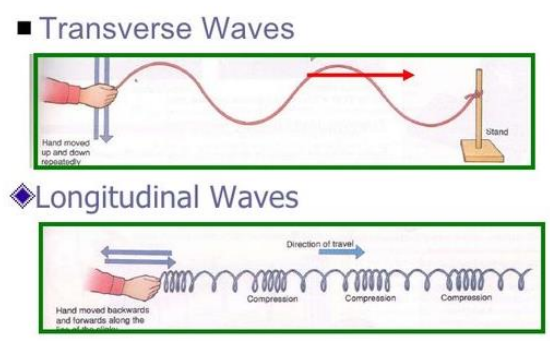
• Examples of transverse waves include; electromagnetism, water waves and S-seismic waves.
• Examples of longitudinal waves include: sound waves and P-seismic waves.
• A wave must be able to demonstrate these three phenomena in order to be considered as a wave.
• Reflection is the change of direction when a wave collides with a reflective barrier.
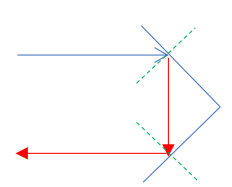
• Refraction is the change of direction when the wave goes through a change of medium.
• Refraction occurs when the direction of motion is not perpendicular to the border between the deep and shallow regions.
• The speed of the water changes when there is a change in the depth of the water.
• From deep to shallow waters, the wave’s speed decreases as the wavelength becomes shorter.
• From shallow to deep waters the wave’s speed increases as the wavelength becomes longer (Hint: recall v = fλ).
• One way to imagine this is to picture deep waters as a broad road allowing many cars to travel and shallow water as a narrow road causing a jam.
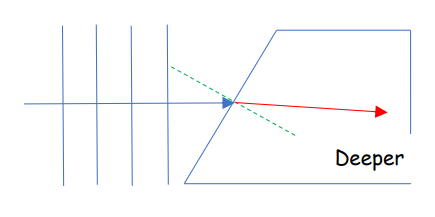
Hint: 1) Draw a line representing the direction of the wave propagation first (blue arrow)
2) Then only draw the normal line (green arrow)
• Diffraction is shown when a wave spreads when the wave passes through an opening or an edge.
• Diffraction increases when the size of the gap decreases or the wavelength of the waves increases.
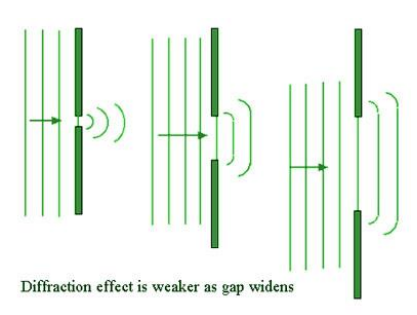
• A ripple tank can be used to demonstrate the above three phenomenon.
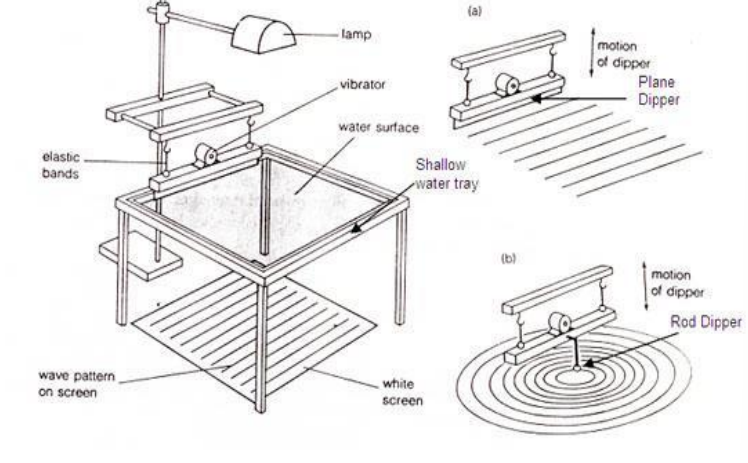
3.2 Light
3.2.1 Reflection of light
CORE
1. Define and use the terms normal, angle of incidence and angle of reflection
2. Describe the formation of an optical image by a plane mirror, and give its characteristics, i.e. same size, same distance from mirror, virtual
3. State that for reflection, the angle of incidence is equal to the angle of reflection; recall and use this relationship
SUPPLEMENT
4. Use simple constructions, measurements and calculations for reflection by plane mirrors
• Light is a wave because it undergoes reflection, refraction and diffraction.
• Reflection
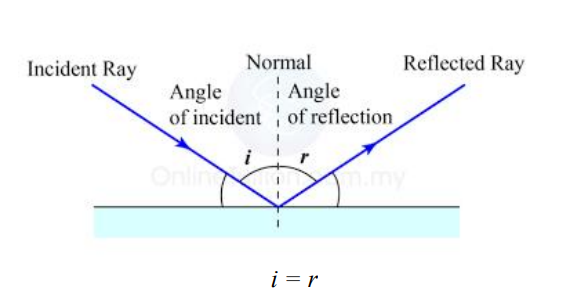
• Types of mirrors
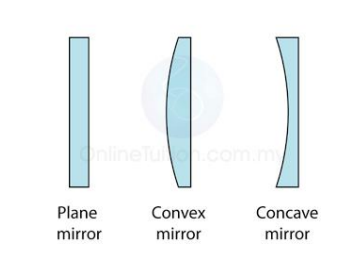
• Reflection in plane mirror
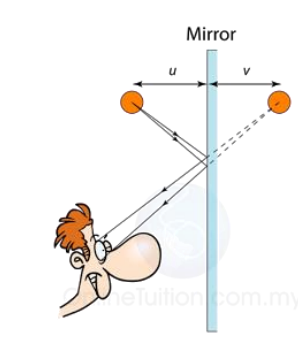
• The image form is upright, virtual, laterally inverted and same size as object.
3.2.2 Refraction of light
CORE
1. Define and use the terms normal, angle of incidence and angle of refraction
2. Describe an experiment to show refraction of light by transparent blocks of different shapes 3. Describe the passage of light through a transparent material (limited to the boundaries between two media only)
4. State the meaning of critical angle
5. Describe internal reflection and total internal reflection using both experimental and everyday examples
SUPPLEMENT
6. Define refractive index, n, as the ratio of the speeds of a wave in two different regions
7. Recall and use the equation
n=\(\frac{sin\;i}{sin\;r}\)
8. Recall and use the equation
n=\(\frac{1}{sin\;c}\)
9. Describe the use of optical fibres, particularly in telecommunications
• Refraction
• Refraction is the bending of light ray at the boundary of two medium as the light ray propagates from a medium to another with different density.
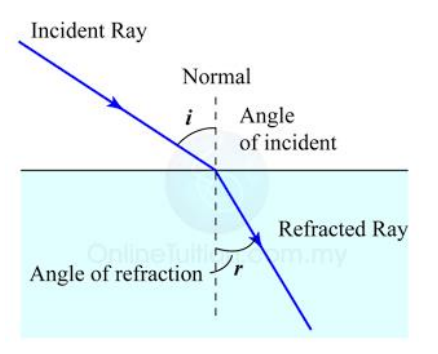
• When light passes through a medium which is denser
i > r
• When light passes through a medium which is less dense
i < r
• Snell’s law states that the value of (sin i) / (sin r) is constant for light passing from one given medium into another
\(\frac{sin i}{sin r}\) = constant , n
Here n is the refractive index. Remember that n>1
• Another equation for refractive index is
Refractive index , n = \(\frac{speed \;of\; light\; in\; vacuum}{speed\; of\; light\; in\; medium}= \frac{c}{v}\)
Note: The greater the refractive index, the denser is the medium. Hence, the speed of light in the medium will be slower.
• Total internal reflection and the critical angle
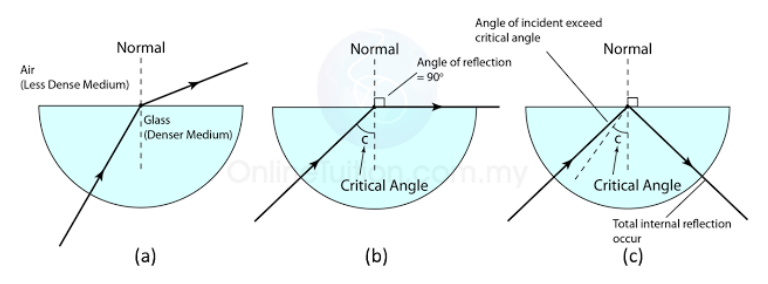
where,
\(n = \frac{1}{sin\;c}\)
Note: The light ray must propagate from an optically denser medium to an optically less dense medium. The angle of incident must exceed the critical angle.
• Some phenomenon related to internal reflection and the critical angle
1) Mirage
2) Rainbow
3.2.3 Thin lenses
CORE
1. Describe the action of thin converging and thin diverging lenses on a parallel beam of light
2 Define and use the terms focal length, principal axis and principal focus (focal point)
3 Draw and use ray diagrams for the formation of a real image by a converging lens
4 Describe the characteristics of an image using the terms enlarged/same size/diminished, upright/inverted and real/virtual
5. Know that a virtual image is formed when diverging rays are extrapolated backwards and does not form a visible projection on a screen
SUPPLEMENT
6. Draw and use ray diagrams for the formation of a virtual image by a converging lens
7. Describe the use of a single lens as a magnifying glass
8. Describe the use of converging and diverging lenses to correct long-sightedness and short- sightedness
3.2.4 Dispersion of light
CORE
1. Describe the dispersion of light as illustrated by the refraction of white light by a glass prism
2. Know the traditional seven colours of the visible spectrum in order of frequency and in order of wavelength
SUPPLEMENT
3. Recall that visible light of a single frequency is described as monochromatic
• For a converging lens (convex lens), when parallel rays of light pass through a lens, they are brought to focus at a point known as the principal focus (f).
• The distance of the principal focus from the lens is called the focal length which depend on the curvature of the lens.
• There are three rules for drawing ray diagram for convex lens
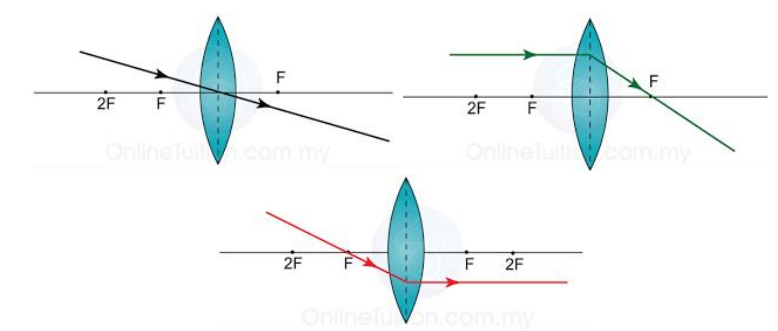
• The characteristics of the image form using a convex lens is always either virtual or real; upright or inverted; magnify or diminish.
• DO NOT memorize the characteristics for different object positions.
• Try to use the three rules and draw them out!!!!
• When light is refracted by a prism, the incidence ray is not parallel to the emergent ray, since the prism’s sides are not parallel.
• If a beam of white light is passed through a prism it is dispersed into a spectrum.
• White light is a mixture of colours, and the prism refracts each colour by a different amount – red is deviated the least and violet the most.
• The seven colours of the spectrum are red, orange, yellow, green, blue, indigo and violet.
• Light is an electromagnetic wave; hence it is a transverse wave.
• Red has the largest wavelength.
• Violet has the shortest wavelength.
• Light of a single wavelength is known as monochromatic.
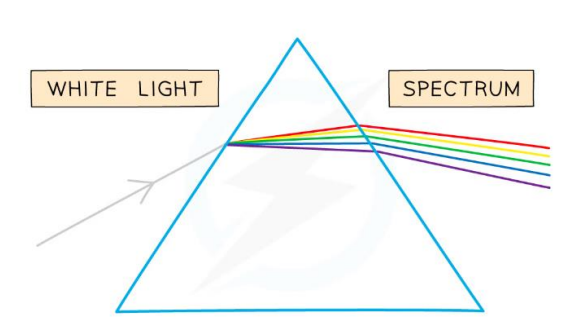
3.3 Electromagnetic spectrum
CORE
1. Know the main regions of the electromagnetic spectrum in order of frequency and in order of wavelength
2. Know that all electromagnetic waves travel at the same high speed in a vacuum
3. Describe typical uses of the different regions of the electromagnetic spectrum including: (a) radio waves; radio and television transmissions, astronomy, radio frequency identification (RFID)
(b) microwaves; satellite television, mobile phones (cell phones), microwave ovens
(c) infrared; electric grills, short range communications such as remote controllers for televisions, intruder alarms, thermal imaging, optical fibres
(d) visible light; vision, photography, illumination
(e) ultraviolet; security marking, detecting fake bank notes, sterilising water
(f) X-rays; medical scanning, security scanners
(g) gamma rays; sterilising food and medical equipment, detection of cancer and its treatment
4. Describe the harmful effects on people of excessive exposure to electromagnetic radiation, including:
(a) microwaves; internal heating of body cells
(b) infrared; skin burns
(c) ultraviolet; damage to surface cells and eyes, leading to skin cancer and eye conditions
(d) X-rays and gamma rays; mutation or damage to cells in the body
SUPPLEMENT
6. Know that the speed of electromagnetic waves in a vacuum is \(3.0 \times 10^8\) m/s and is approximately the same in air.
• Electromagnetic waves are transverse waves.
• It consists of electric field and magnetic field components.
• It can propagate without the need of a medium to carry them unlike mechanical waves.
• The speed that electromagnetic waves travel at is \(3\times 10^8 ms^{-1}\)
• If this number seems familiar it’s because that’s the speed of light.
• Light is a wave or more specifically an electromagnetic wave.
• There are seven types of waves in the electromagnetic spectrum as shown below.
• Based on the diagram below, frequency (f) increases from left to right.
• While wavelength (λ) decreases from left to right.
• This is due to v = f x λ
• The speed of the wave is constant (v), hence if the frequency (f) decreases the wavelength (λ) must increase to compensate.
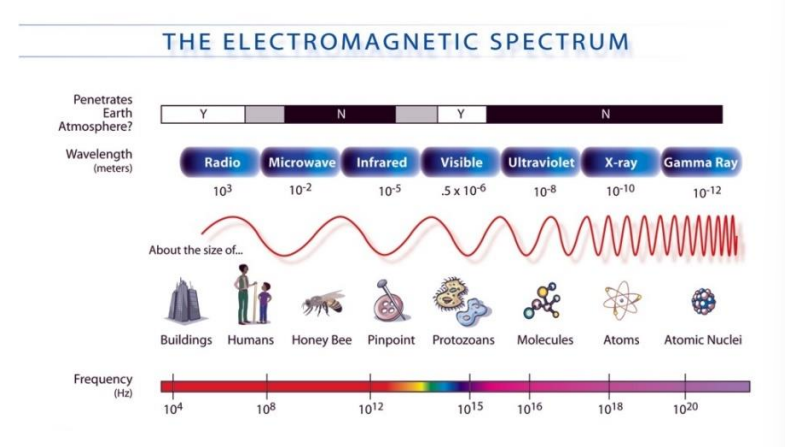
CORE
5. Know that communication with artificial satellites is mainly by microwaves:
(a) some satellite phones use low orbit artificial satellites
(b) some satellite phones and direct broadcast satellite television use geostationary satellites
SUPPLEMENT
7. Know that many important systems of communications rely on electromagnetic radiation including:
(a) mobile phones (cell phones) and wireless internet use microwaves because microwaves can penetrate some walls and only require a short aerial for transmission and reception
(b) Bluetooth uses radio waves because radio waves pass through walls but the signal is weakened on doing so
(c) optical fibres (visible light or infrared) are used for cable television and high-speed broadband because glass is transparent to visible light and some infrared; visible light and short wavelength infrared can carry high rates of data
8. Know the difference between a digital and analogue signal
9. Know that a sound can be transmitted as a digital or analogue signal
10. Explain the benefits of digital signaling including increased rate of transmission of data and increased range due to accurate signal regeneration.
• Electromagnetic radiation is used for communication and transmission of information.
• The waves that are used in this way are radio waves (radio), microwaves (mobile phone, Bluetooth and WIFI), infrared radiation (aircon remove control) and visible light (optical fiber).
• The method of communication requires the use of a code or signals.
• There are two types of signal
1) Analogue
2) Digital
• An analogue signal changes in frequency and amplitude with time.
• A digital signal has only 0s and 1s
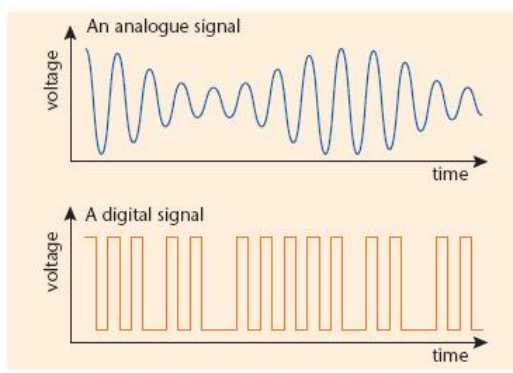
• Digital signals have advantages over analogue signals.
• Digital signals have increased capacity, better quality and can be stored and processed by computers.
• Increased capacity allow digital signals to carry more information compared to analogue.
• Both digital and analogue can pick up unwanted signals that distort the original sound (remember hearing static over radio?)
• However, the advantage of digital is that noise in digital signals can be clean up in process known as regeneration because each pulse is 0 or 1 other values can be removed.
CORE
1. Describe the production of sound by vibrating sources
2. Describe the longitudinal nature of sound waves 3 State the approximate range of frequencies audible to humans as 20 Hz to 20 000 Hz
4. Know that a medium is needed to transmit sound waves
5. Know that the speed of sound in air is approximately 330-350 m/s
6. Describe a method involving a measurement of distance and time for determining the speed of sound in air
7. Describe how changes in amplitude and frequency affect the loudness and pitch of sound
waves
8. Describe an echo as the reflection of sound waves
9. Define ultrasound as sound with a frequency higher than 20 kHz
SUPPLEMENT
10. Describe compression and rarefaction
11. Know that, in general, sound travels faster in solids than in liquids and faster in liquids than in gases
12. Describe the uses of ultrasound in non- destructive testing of materials, medical scanning of soft tissue and sonar including calculation of depth or distance from time and wave speed
• Recall that sound waves are longitudinal waves.
• Sound waves are mechanical waves as they require a medium to propagate through.
• Sound waves travel through solid, liquid and gas by “passing along” the vibration from one particle to the next.
• Hence the speed of sound is highest in solids (concrete: 5000m/s) then in liquids (pure water: 1400m/s) and slowest in gases (air: 330m/s)
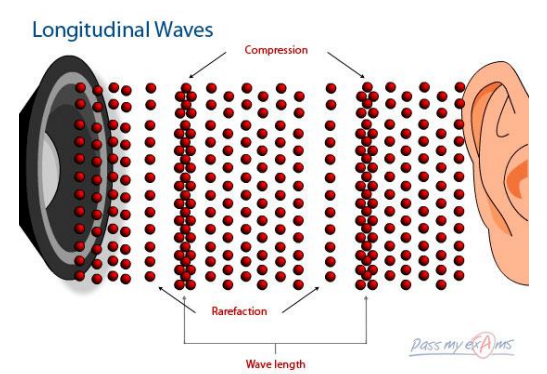
• The speed of sound can be calculated by using
Speed of sound = \(\frac{𝐷𝑖𝑠𝑡𝑎𝑛𝑐𝑒\; 𝑡𝑟𝑎𝑣𝑒𝑙𝑙𝑒𝑑\; 𝑏𝑦\; 𝑠𝑜𝑢𝑛d}{𝑇𝑖𝑚𝑒 𝑡𝑎𝑘𝑒n}\)
• An echo is produced when sound is reflected of a surface
• Pitch is related to the frequency of the sound.
• The greater the frequency, the higher the pitch.
• Humans can hear between 20 Hz and 20 kHz.
• Human vocal range is between 80 Hz to 1100 Hz.
• Soprano singers would be in the higher range of frequency while bass singer would be on the lower!
• Sound waves less than 20 Hz are known as infrasound while those above 20 kHz are known as ultrasound.
• Loudness is related to the amplitude of the sound. The bigger the amplitude the louder the sound.